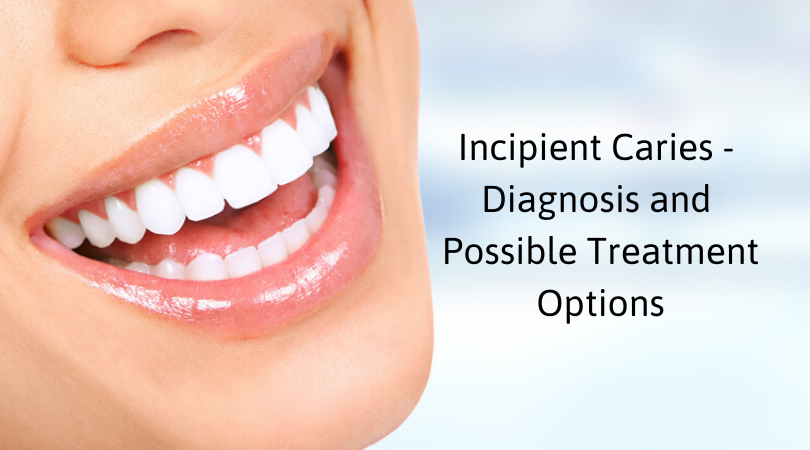Incipient Caries – Diagnosis and Possible Treatment Options
In dental practice, it is customary to distinguish 4 forms of dental caries:
- incipient caries, looking like a spot;
- superficial caries;
- medium caries;
- deep caries.

Incipient and superficial caries are early forms of caries.
Incipient tooth decay or caries in the early demineralization is the first stage of the carious process on the teeth. Such an incipient lesion is characterized by the presence of white and dark spots on the enamel, under which there is a violation of hard tissue structure. This form may be treated with proper care for the affected tooth.
Superficial tooth decay or caries is an intermediate form between primary and secondary caries. With superficial caries, enamel integrity is violated, that is, the formation of a small cavity within the upper layers of the tooth.
Causes of incipient and superficial caries
Acid-forming bacteria. The key role in the appearance of the incipient forms of caries is played by pathogenic microorganisms (microbes), which form acids. Organic acids cause the enamel permeability violation, useful minerals (primarily calcium, fluorine, phosphorus) are washed out of the tooth, which makes the tooth more fragile.
Poor oral hygiene. In order for bacteria to grow and multiply, carbohydrate residues must remain on the tooth surface after eating, which serves as a substrate for the attachment of microbes. It is necessary to brush your teeth 2 times a day for 2-3 minutes and use floss or irrigator to remove food residues from the teeth surface.
Hereditary factors. Genetics plays an important role in the appearance of initial dental caries. The teeth are under overload during the pregnancy, so the nature of the nutrition, the general condition of the body of the future mother affects the health and state of the child’s teeth.
Unbalanced diet. The prevalence of sugary, flour, carbonated drinks, fast food in the diet contributes to the early forms of caries.
If you visit the dentist on time, that is, at least 1 time every 6 months, then this will significantly reduce the risks of the onset and development of incipient and superficial caries on the teeth.
What is incipient caries and how it looks like?
Incipient caries is an initial stage of tooth decay. At the initial stage of caries, there appear spots on the tooth from dull white to dark brown. In such cases, the patient may complain of aesthetics.
With superficial caries, a subtle shallow cavity with rough edges appears on the tooth. The main complaint with superficial caries can be a feeling of soreness when a person eats sweet, sour, salty foods.
Incipient caries’ diagnosis
The dentist holds different tests in order to define the presence of pathology.
- Visual inspection. Any professional examination begins with a visual assessment of all tooth surfaces.
- Periodontal probing. The dentist probes on the outer part of the tooth, revealing roughness, irregularities, and carious cavities. At initial caries, the tooth surface is smooth, and with surface caries, small enamel cavities are determined.
- Tooth resorption. The dentist blows air into the tooth in order to remove moisture from the surface and see the foci of demineralization: areas with a reduced enamel density.
- Staining. In dental practice, a dentist can use caries indicators to detect caries – dyes that stain the tooth surface. Absorption of the dye indicates that a carious process is developing there.
- X-ray diagnostics. On an x-ray image, a specialist can see early forms of caries.
Treatment of incipient and superficial caries
Incipient caries is considered a reversible form of caries. Treatment consists of saturating the tooth with useful minerals. The process of saturation of tooth enamel with necessary substances is called remineralization. Remineralization can be of 2 types:
- endogenous. This process implies that minerals enter the tooth enamel along with water, nutrition, vitamin complexes, that is, “from the inside” of the body.
- exogenous. This process implies that macro- and microelements enter the tooth from “outside”, that is when applying special pastes, solutions, gels.
The main elements that strengthen tooth enamel are calcium, fluorine, phosphorus.
It is recommended to keep a diet rich in dairy products, seafood, protein foods, vegetables, cereals, legumes, greens to remineralize teeth.
An important point is the intake of vitamin and mineral complexes, but only after consulting a specialist. It is not recommended to self-prescribe vitamins.
Professional oral hygiene is necessary before the course in order for pastes, varnishes, solutions containing important minerals to be effective. The dentist will remove all dental deposits (stones, plaque) from the tooth surface. As a result, substances can be absorbed into the dental tissue.
At the consultation, the dentist will draw up an individual treatment plan, talk about what treatment options should be used in your case.
Category: Health and Wellness
Tags: dental care, dental caries, incipient caries